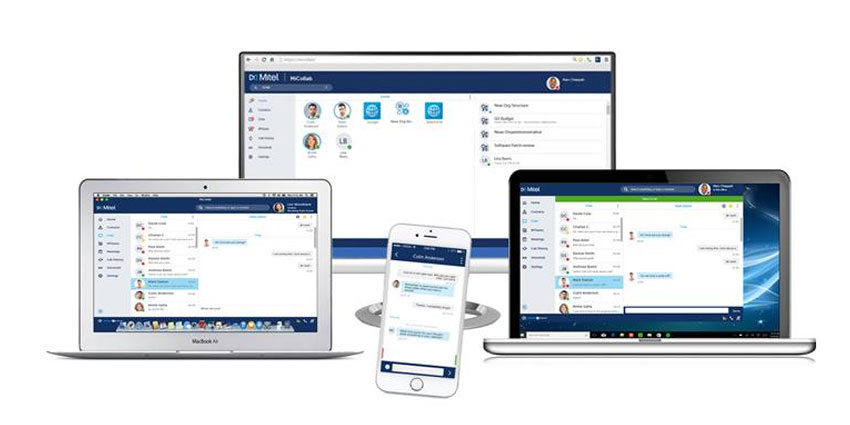With developments in technology moving at the pace they do, nothing stands still for very long anymore in the world of telecommunications. The old certainties have gone, and the market seems to be in a near constant state of disruption and flux.
It would be easy for old industry stalwarts like Canada’s Mitel to be left behind by the new order. As it is, Mitel has done just the opposite. By embracing all things IP, mobile and multi-platform, the one time telephony specialist has actually been in the vanguard of ushering in the Unified Communications era. $1bn in global revenues says it has made a pretty good fist of things.
And so we come on to Mitel’s MiVoice MX-ONE. Developed originally by Aastra, which Mitel bought in 2013, as an IP telephony server with a software-only option, Mitel now describes MX-ONE as “a fully integrated SIP-based communications solution.” Phrases like ‘voice’, ‘IP PBX’ and ‘telephony’ are conspicuous by their absence in Mitel’s marketing materials – instead, terms like ‘Unified Communications and Collaboration (UCC)’, ‘full-featured communications’’ and ‘multimedia’ come very much to the fore.
Mitel has also built considerably on Aastra’s original software-only deployment option. Nowadays, MX-ONE is primarily a software solution. If you want it to be run on a physical server, it can be. But central to the offering is the ability to run MX-ONE in the datacentre, in a virtualised environment, or as a cloud-based service.
With the MX-ONE, Mitel fully embraces software-based, cloud-ready SIP solutions. Amongst the benefits this offers customers, the company talks about MX-ONE ‘opening up’ the closed architectures of proprietary based systems, offering greater flexibility to adapt and rationalise communications systems than ever.
Mital also talks about the future facing possibility of SIP standards, how the ready integration of voice, IM, collaboration and especially video is what mainstream of business communication will look like in a few years. With the MX-ONE, could Mitel be preparing for the end of telephony’s reign as king of comms?
Here we’ll ask how opening up communications architectures can benefit the customer, and whether software focused options like MX-ONE really are paving the way for UC to overtake voice. As always, the views expressed in this review are solely those of the author only. UC Today does not endorse or promote any particular brands or products, offering a completely independent service to vendors, resellers and buyers in the UC industry.
How Does It Look?
MX-ONE is available in hardware form in one of two classic 19” rack mountable PBX chassis originally developed by Aastra – the MX-One Lite, a 3U chassis, and the MX-One Classic, a 7U chassis. On their own, these chassis now only provide media gateway functions, but server functions can be added via one of two Intel-based server boards, the ASU or ASU Lite. The ASU can also be purchased as a 1U chassis without a media gateway, and there is also a separate, media gateway only MX-ONE 1U chassis,
What Can It Do?
At the core of the MX-ONE architecture is the concept of communications convergence – voice, video, text, collaboration and data shared together over a single network infrastructure, whether on premises or mobile, single site or distributed worldwide. Moreover, however you deploy MX-ONE solutions, it offers sweeping flexibility to configure and combine functions the way you want, with flexible application licensing.
MiVoice MX-ONE is made up of three distinct components – a MiVoice MX-ONE Service Node, MiVoice MX-ONE Media Gateway (hardware) / Media Server (software) and the MiVoice MX-ONE Management Suite. MX-ONE Service Node is the server software which drives the system. As a single configuration, it can support up to 15,000 SIP users and 15 media gateways. As a virtual server in VMware environments or when deployed as an SaaS solution, it can support up to 500,000 users.
The three available media gateway chassis all provide digital signal processing functions, including transcoding between TDM and IP/SIP telephones to offer backwards compatibility with legacy phone systems. The software media gateway equivalent, the MX-ONE Media Server, provides RTP media resources and manages protocol conversion between the likes of SIP and H.323, ensuring broad compatibility between a wide range of multimedia and multiplatform communication functions.
The MX-ONE Manager Suite provides three system administration consoles:
- MX-ONE Service Node Manager is a web-based interface for system administrators;
- MX-ONE Provisioning Manager is another browser-based GUI for users to manage applications and endpoints;
- Mitel Performance Analytics, which can be downloaded onto a datacentre or accessed via the cloud, offers proactive fault detection and performance management tools for the whole system.

MX-ONE provides access to Mitel’s full suite of UCC software products, including MiCollab, MiCollab Audio, Web and Voice Conferencing, MiCollab Advanced Messaging, MiVoice Call Recording, Mitel InAttend and MiContact Centre Enterprise.
Through the application licensing system, businesses can pick and choose from the broad range of UCC tools these applications offer precisely suit their needs. And because of the converged infrastructure, everything can be managed efficiently from the same IP operation and management platforms.
Moreover, these tools are available wherever you may need them. The Mitel Mobile Client, available for Android, iOS and Blackberry, connect mobile devices to the MX-ONE network as normal SIP users.
The ability to virtualise the entire system in VMware environments reduces the hardware footprint and administration burden even for large dispersed organisations. But it is also the basis for MX-ONE SaaS, where virtualised MX-ONE systems are hosted by a third party provider and licensed out to businesses on a subscription basis.
The availability of MX-ONE as a cloud service offers several benefits. MX-ONE is a powerful enterprise class communications solution, but it is also a big, complex product. SaaS not only means you don’t have to buy any of the server software / hardware yourself, you also don’t have to do any of the set up and management. Whenever you want to add a new application tool or extend the network for new user extensions, someone else does it for you. This makes scaling up, including opening new branches, extremely easy and cost efficient – as long as you have endpoints plugged into an IT network with an IP connection, the whole suite of MX-ONE functions is essentially available via the internet.
What do we like?

There is a lot to MiVoice MX-ONE, and a lot to be impressed with. The scope for scaling up to many thousands of users whilst still managing the network centrally over a straightforward browser based console, the range of Mitel UCC products available, the flexibility to choose between hardware, virtual environment and cloud deployment options in combinations which suit the needs of your business – all are key pluses.
Another thing to highlight is also the benefits MX-ONE SaaS offers to channel partners. This is not only a boon to established hosted providers who can draw on the profile and reputation of Mitel in marketing their services. It also provides an opportunity for resellers looking to diversify their business and respond to market demand for UCaaS. The ability to offer Mitel hardware, software and platforms as a service means resellers can cover all bases.
Who is it for?
The number of users the MX-ONE can support puts it into the enterprise class. But with the MX-ONE Express option, and the wide scope for shaping the solutions according to the size and needs of the business offered via SaaS, MX-ONE is also a viable option for the midmarket. The ability to run MX-ONE from datacentre servers, in VMware and as a cloud service will all appeal to businesses looking to save costs from their communications by cutting back on hardware and maintenance.
What is it compatible with?
With its open, standards based architecture, the MX-ONE is widely compatible with non-Mitel backend and application platforms. The Service Node can be operated on most Intel-based servers and as a turn-key server solution on Dell PowerEdge R320/330 servers. Mitel UCC software products offer a range of plugin options with third party software.
UC Today Opinion
So does the MX-ONE signal the future of business communications beyond telephony? Mitel has done an interesting thing with MX-ONE, taking an IP PBX with software-only capabilities and focusing very much on the software. This is perhaps where the real story lies in the MX-ONE, in the flexibility of deployment, the scalability, the provision as a cloud service, rather than the marketing material focus on UCC over phone.
In practice, MX-ONE does not actually provide any of its own embedded UCC functions, it simply makes them available through the Mitel suite of software products. In that sense, it is similar to MiVoice Business, another ‘server independent’ Mitel solution which is marketed much more recognisably as a VoIP product.
Overall, powerful, dazzling in its scalability, innovative in its deployment options.
Have you had any experiences with the MiVoice MX-ONE, either as a user or as a reseller? What are your thoughts? How have you seen it deployed? And do you see it as more than a VoIP solution? Feel free to share your opinions in the comments section below, and why not share this article on social media and invite friends and colleagues to join in the conversation.







